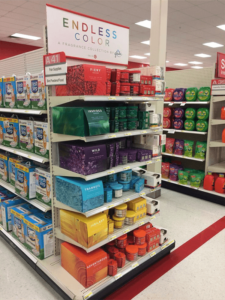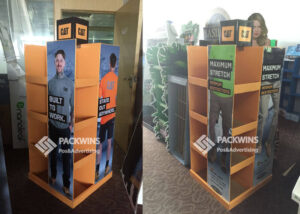In today’s competitive retail environment, making every square metre count is essential. One of the most valuable zones in-store is the end-of-aisle or “endcap” location. This guide walks you through everything you (as a brand owner, retailer or display partner) need to know about endcap displays — from why they matter, to design best-practices, to implementation and measurement.
1. What Is an Endcap Display – and Why It Matters
An “endcap” display is a fixture placed at the end of a retail aisle. It sits in high-traffic sightlines and is designed to draw shopper attention. Because of its visibility and impulse-trigger potential, an endcap is often considered premium retail real estate. For example, one study found end-of-aisle displays generate notable uplifts in both exposure and sales.
From a manufacturing or display-supplier perspective (such as Packwins’s corrugated displays), the endcap location offers a powerful opportunity to deliver value to your brand or retailer partner by offering an exceptional fixture that performs. Here is a guide to using endcap displays.
2. The Key Benefits of Using Endcap Displays
Here are the most important benefits for a brand or retailer to justify investing in a strong endcap display:
- High visibility & foot traffic: Because endcaps sit at the end of aisles, they intercept shoppers more often than inline shelf facings. Studies indicate as much as a 93 % increase in exposure for items placed on endcap and help you sell more products.
- Impulse purchasing: Endcaps tap into impulse behaviour. Some reports show meaningful lifts in sales (e.g., ~32 %+ sales lift) when products are featured on endcaps versus standard shelf positions.
- Brand-building & awareness: Because you’re able to highlight a product or line in a visually distinct way, you gain branding power and differentiation.
- Efficient use of space: Endcaps allow you to expand your selling space without needing more floor footprint, making them an efficient tool for promotional or seasonal campaigns and gain benefits from endcap displays.
- Flexibility for promotion: Endcaps can be used to spotlight new launches, seasonal items, clearance stock or cross-merchandising opportunities, making them very versatile.
3. Design Principles That Drive Conversions
Having an endcap in a prime location is only the first step — design and execution make the difference. Here are some practical design principles your customers (retailers or brand-owners) should focus on:
a) One clear message / focus
Don’t try to say everything at once. The best endcaps have one theme or idea — a product launch, a seasonal promotion, a bundle, etc to Increasing Sales through Visual Merchandising.
b) Strong branding & visuals
Use brand colours, signage, clear product facings, and signage that directs attention and communicates value. The visual must stand out but align with the brand.
c) Shopper-flow & accessibility
Products should be reachable, the display should not block traffic flow, and the layout should make sense (eye-level items, easy grab, minimal confusion). Good arrangement supports conversions.
d) Material & structure quality
Especially in the case of corrugated cardboard endcaps (which Packwins services), strength, ease of assembly, flat-pack logistics, and durability matter. A flimsy display erodes brand presence and sales.
e) Refresh and rotate
To maintain consumer interest, rotating products, imagery or seasonal themes every 7-14 days (or according to retailer cadence) helps keep the endcap relevant.
f) Consider tech & interactivity
Digital endcaps (screens, interactive elements) are increasingly used. While not always necessary, adding dynamic content can boost engagement — but beware over-complexity (some research shows too vivid = diminishing returns).
4. Custom vs. Standard Endcap Displays: Which Should You Choose?
As a manufacturer and supplier, you’ll want to guide your customers through this decision.
- Standard off-the-shelf endcaps: Often quicker and lower cost. Good for shorter campaigns or budget promotions.
- Custom-engineered endcaps: Allow full brand alignment (form-factor, finishes, structure, special features). Ideal for major brand campaigns, club-store roll-outs (e.g., Walmart, Target) or high-impact launches.
- Material considerations: Corrugated displays (what you specialise in) offer sustainability benefits, ease of customization, flat-pack logistics and cost-effectiveness compared to rigid fixtures.
- Lead-time & logistics: Custom means longer lead time — design → prototyping → production → shipping. Standard may allow shorter turn-arounds.
- Retailer compliance & rollout: Many major stores require approved fixtures in their planograms. Custom designs may require pre-approval or testing.
- ROI calculus: If a custom endcap greatly increases sales or supports premium pricing, the extra cost may pay off. The research shows that placement uplifts can be substantial thuslead to ROI of Upgrading Visual Merchandising in Retail.
5. How to Plan Your Endcap Display Campaign
Your clients (brands/retailers) will have many concerns — you as supplier can help them structure a solid plan:
- Define campaign objective: Is it new product launch, seasonal promotion, clearance or awareness? Goals could be X % sales lift, Y units moved, Z brand impressions.
- Select the right product(s) and offer: Choose SKUs suited for endcap placement (impulse-friendly, high margin, new or seasonal). Research shows the right SKU mix matters for endcap optimization.
- Design brief & prototyping: Collaborate on structural design, branding, messaging, print. For corrugated displays, validate strength, ease of assembly, flat-pack size and shipping.
- Production & quality control: Ensure sample-to-mass production consistency. Your factory in Shenzhen should emphasise QC, repeatability, and shipping logistics.
- Logistics & shipping: Flat-pack shipping reduces cost, simplifies inbound for retailer. Plan for customs, freight, local delivery and store installation.
- Store rollout & execution: Ensure planogram compliance, placement accuracy, signage & display setup. Poor in-store execution (under-stocking, mis-placement) undermines performance.
- Training & stocking: Retail associates should know how to assemble/maintain the display, restock, and keep it looking optimal.
- Measurement & follow-through: Define KPIs (sales lift, units sold, ROI, brand awareness) and gather data post-campaign. Use that to refine future campaigns.
6. Logistics and Setup Tips for Retailers
From the display supplier’s standpoint, helping your retailer customer with these practical tips can boost success:
- Use flat-pack designs so the display ships efficiently, stores easily and assembles quickly at store level.
- Provide clear assembly instructions, preferably pictorial or video.
- Pre-plan fixture weight, load-bearing capacity (important for pallet displays or heavy packages) so it won’t collapse or appear cheap.
- Prioritise material durability — corrugated should be strong enough for store handling and transit; lamination or reinforcement may be needed.
- Ensure compliance with retailer guidelines (height, footprint, aisle width, fire-safety, SKU facing rules) — major chains often have strict rules.
- Suggest regular reset frequency — rotating displays, changing themes or refreshes can keep the space dynamic rather than stale.
- Allow re-use or recycling where possible — emphasize the sustainability of corrugated materials (which is a strong selling point).
7. Common Mistakes to Avoid with Endcap Displays
Here are frequent pitfalls your customers may face — and you can proactively advise them:
- Cluttered or confusing messaging: Too many SKUs, multiple brands, mixed messages reduce impact.
- Poor placement or low quality materials: If the display is in the wrong location or looks cheap, the premium real-estate value is wasted.
- Ignoring shopper flow and eye level: Endcaps must consider how shoppers approach and move past aisles; one study found back-aisle endcaps generated higher overall brand uplift than front endcaps.
- Failure to maintain / restock the display: An under-stocked or messy display not only loses sales but damages brand perception.
- Over-reliance on static design when digital might work better: If you have a high-traffic location and investment budget, digital endcap solutions can outperform but require more upkeep and cost.
- No measurement or feedback loop: If you don’t measure performance, you can’t prove ROI or improve future campaigns.
8. Measuring the Success of Your Endcap Display
To deliver tangible value to your customers, measurement is key. Some useful metrics:
- Sales uplift: Compare units sold via the endcap campaign vs baseline shelf performance. Research reports typical lifts of ~30 % for well-executed endcaps.
- Units moved / weeks supplied: How fast did the display turn through inventory?
- Return on investment (ROI): Compare cost of display (design + production + shipping + installation) vs incremental margin gained.
- Foot traffic / exposure: Using retailer foot-traffic data or shopper-flow modelling, assess how many shoppers passed and engaged the display.
- Brand awareness / perception: Pre-/post-surveys or retailer feedback about brand visibility.
- Planogram compliance and execution quality: Audit if the display was set up correctly, fully stocked, located in the planned zone — because poor execution can nullify even a great fixture.
By analysing these metrics and reviewing what worked/what didn’t, you and your client can iterate on future campaigns, improving design, product choice, timing and logistics.
9. Why Choose Packwins for Your Endcap Display Projects
As you position your manufacturing and design services, here’s how you can frame your value proposition to clients (brands or retailers):
- Custom structural design tailored to your product and retail chain: From material choice, to size, to logistics-friendly flat-pack formats, your expertise ensures the endcap fits both brand and store requirements.
- Fast prototyping and sample verification: You deliver samples quickly so brands can test in-store or with focus groups before mass production.
- Consistent quality from sample to mass production: With your Shenzhen-based factory you ensure the same build, materials and printing quality.
- Global logistics and shipping support: You handle shipping from China, customs clearance, and delivery to store or distribution centre — valuable for international brand clients.
- Sustainability credentials: Emphasise corrugated material, recyclability, flat-pack shipping benefits and reduced waste — appealing to eco-conscious brands and retailers.
- End-to-end service: From concept/design to prototyping, production, shipping and installation advice — you’re a single-source supplier, which simplifies procurement for your clients.
Final Thoughts
Endcap displays represent one of the highest-impact in-store merchandising tools available. When done right — with strategic product selection, intelligent design, strong execution and measurement — they drive visibility, impulse purchase and brand growth. As a manufacturer, design specialist and supplier (like Packwins), offering comprehensive endcap services puts you in a strong position to help brands and retailers maximise this real-estate. Incorporate best practices in design, logistics and measurement and you’ll help your clients not just place a display — but deliver sales uplift, brand impact and ROI.



